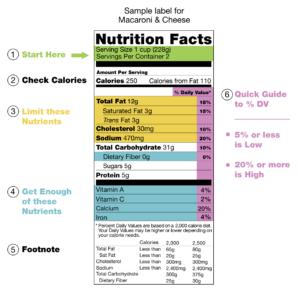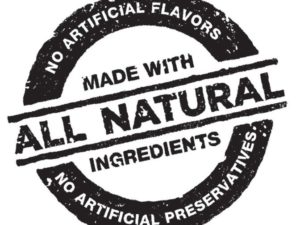 What is a nutrition label?
What is a nutrition label?
It’s no secret that we are what we eat, but nutrition literacy isn’t taught in schools and for most people, it’s not taught at home either. To further understand our relationship with food, weight, and health, we must understand what we are putting into our bodies.
Serving Size
Each product will list the serving size and the amount of servings per package. The nutritional facts listed will pertain to serving size, so if you’re eating two servings, you’re getting twice the number of calories, carbs, fats, etc. Look at your portion sizes and see if there’s room for change.
Daily Value or DV
Daily Values listed on the nutrition label reflect the percentage of your nutritional intake for the entire day, calculated at roughly 2.000 calories per day. Low is 5% or less of a daily nutrient, high is 20% or more of a daily nutrient. Aim for low percentages in saturated fats, trans fats and sodium and sugars. Aim high in vitamins, fibers and minerals. Figure out where you may be lacking in certain nutrients and supplement so that you are getting the maximum nutrition daily.
Sugar and additives
Sugar can be naturally occurring, like in fruits (fructose) or milk (lactose). These are a part of a whole food that delivers many other nutrients, vitamins and fibers. But table sugar (sucrose) and other sugars are added to our foods in high quantity. Other names for sugar as listed on labels include fructose, dextrose, maltose, evaporated cane juice. Additives include High Fructose Corn Syrup, artificial sweeteners or flavoring, food coloring or dyes, and thickeners. These chemicals can have adverse effects on glucose tolerance, blood sugar levels, digestion and cholesterol levels.
Ingredients List
Any product with more than one ingredient must have the ingredients listed. The higher up on the label an ingredient is listed, the more of that ingredient is present in the product, which is calculated by weight. A good general rule would be if the first few ingredients listed are not foods or water, you might want to find an alternative.
 Marketing
Marketing
Often, we buy a product because the package looks appealing or sends a message. It would benefit us to learn what these marketing messages mean. Below are some great examples:
- Low calorie: 40 calories or less per serving.
- Low cholesterol: 20 milligrams or less and 2 grams or less of saturated fat per serving.
- Reduced: At least 25 percent less of the specified nutrient or calories than the usual product.
- Good source of: Provides at least 10 to 19 percent of the Daily Value of a vitamin or nutrient per serving.
- Excellent source of: Provides at least 20 percent or more of the Daily Value of a vitamin or nutrient per serving.
- Calorie free: Less than five calories per serving.
- Fat free/sugar free: Less than ½ gram of fat or sugar per serving. Often, a food labeled as fat free can be loaded with additives to make up for the loss of flavor.
- Low sodium: 140 milligrams or less of sodium per serving.
- High in: Provides 20 percent or more of the Daily Value of a specified nutrient per serving.
- Gluten-Free: Gluten is often replaced with highly refined, high-glycemic starches, like corn starch, potato starch and tapioca starch, and may also be loaded with sugar.
- All- Natural: Natural does not necessarily mean healthy. Cane sugar is still sugar. High Fructose Corn Syrup is made from corn, which is natural, but not healthy.
Bottom line, educating ourselves on what we consume empowers us to make healthier choices and learning what is a nutrition label is a good place to start.

5